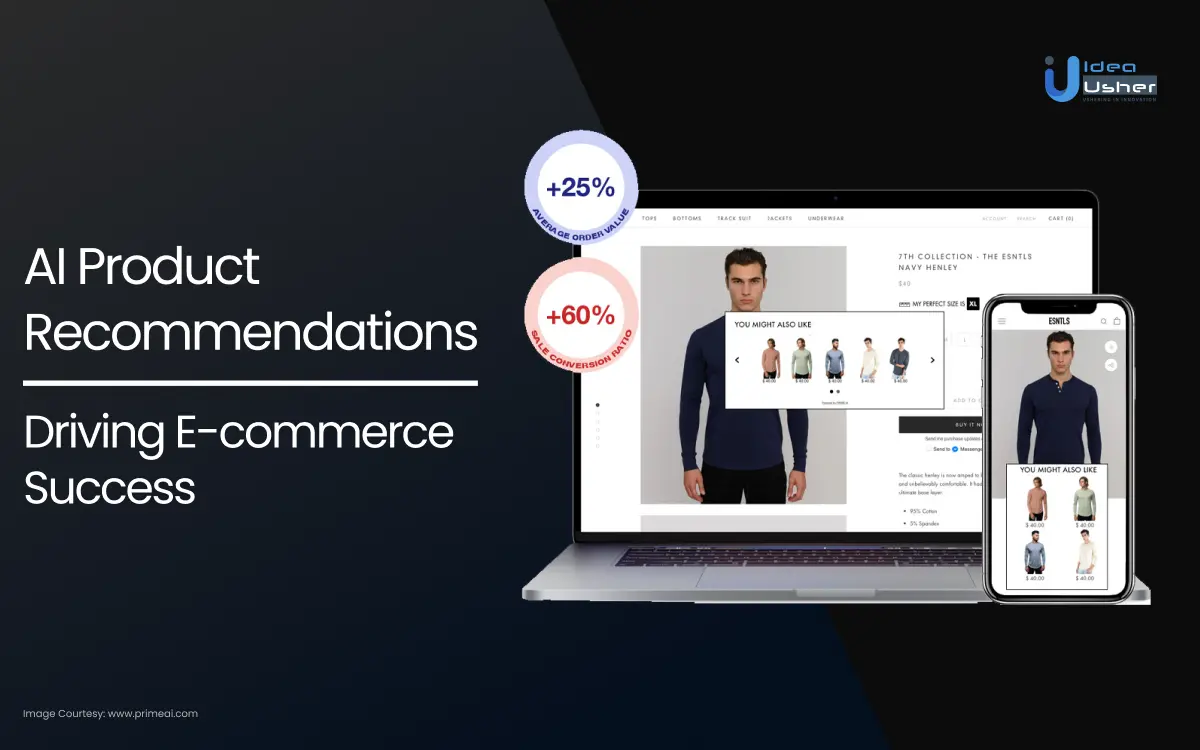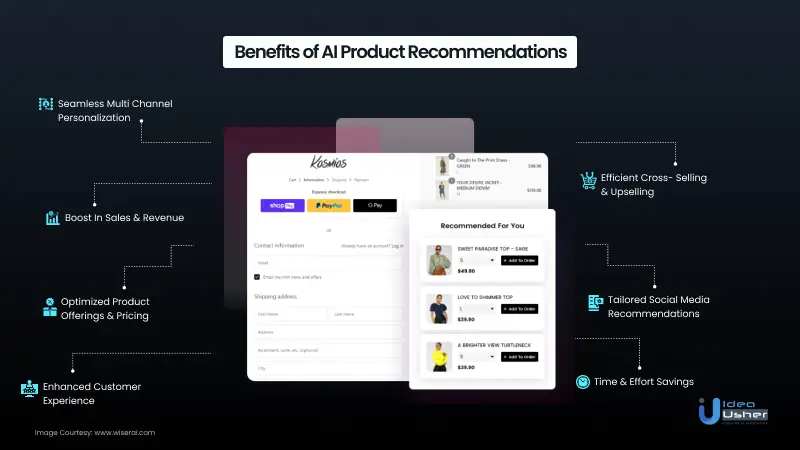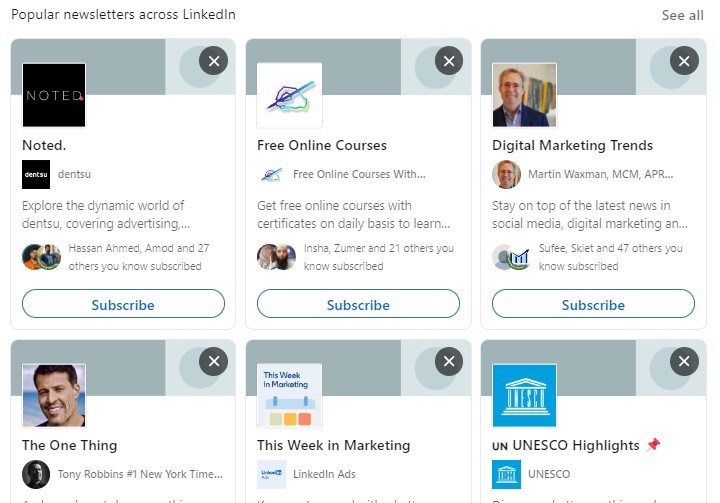- What Are AI-Powered Product Recommendations?
- Why Are Businesses Utilizing AI-Driven Recommendations For Their Products?
- Types Of Recommendation Systems Powered By AI
- How AI-Enabled Product Recommendations Work – A Brief Overview
- 6 Ways That AI-Based Product Recommendations Help In Conversion
- Top 6 Use Cases Of AI Recommendation System
- Top 14 Businesses Utilizing AI Product Recommendations
- Challenges Faced By Recommendation Systems
- The Future Of AI In Recommendation
- Conclusion
- Would You Like To Develop A Recommendation System Powered By AI?
- FAQ

If you’ve ever felt the frustration of a customer browsing your online store but leaving empty-handed, then you understand the power of a well-placed nudge in the right direction. You probably know how important it is to suggest products to your customers. It’s a great way to sell more stuff and make your customers happy. Nowadays, many businesses are turning to AI product recommendations. These are recommendations powered by smart computer programs. They’re becoming really popular because they can help boost sales and keep customers interested. In this blog, we’ll talk about why using AI for product suggestions can be super helpful for your online business. Let’s explore the perks and potential of adding AI-driven product recommendations to your business!
- What Are AI-Powered Product Recommendations?
- Why Are Businesses Utilizing AI-Driven Recommendations For Their Products?
- Types Of Recommendation Systems Powered By AI
- How AI-Enabled Product Recommendations Work – A Brief Overview
- 6 Ways That AI-Based Product Recommendations Help In Conversion
- Top 6 Use Cases Of AI Recommendation System
- Top 14 Businesses Utilizing AI Product Recommendations
- Challenges Faced By Recommendation Systems
- The Future Of AI In Recommendation
- Conclusion
- Would You Like To Develop A Recommendation System Powered By AI?
- FAQ
What Are AI-Powered Product Recommendations?
AI-powered product recommendations act like smart shopping assistants, using data analysis tools to suggest the perfect products for each customer. These assistants analyze customer behavior, uncovering hidden preferences through past purchases, explored items, and even abandoned carts. This vast knowledge allows them to customize recommendations with laser focus, exceeding the capabilities of traditional methods.
It is like a virtual assistant who not only understands what you search for but also predicts what might pique your interest. This fusion of search data and merchandising creates a personalized shopping experience akin to having a friend guide you through a treasure trove of hidden gems.
Modern search engines, powered by natural language processing (NLP), act as expert detectives. They meticulously analyze your searches, decipher your intent, and unearth the results that resonate most deeply with your needs. NLP is the secret weapon behind this remarkable precision, ensuring an efficient shopping experience.
Why Are Businesses Utilizing AI-Driven Recommendations For Their Products?

In e-commerce, utilizing AI-powered product recommendations isn’t merely a choice—it’s a strategic imperative. Here’s a comprehensive breakdown of why businesses should embrace AI-driven recommendations:
1. Enhanced Discoverability Beyond Bestsellers
While traditional bestseller recommendations offer a straightforward revenue boost, relying solely on them can lead to saturation and missed opportunities.
AI-powered recommendations analyze customer-product relationships, uncovering hidden connections that may go unnoticed with manual analysis. By exploring uncharted territories within your data, AI opens doors to untapped revenue streams that transcend the limitations of bestsellers.
2. Avoiding Saturation and Catering to Diverse Audiences
Bestseller recommendations tend to favor established products, potentially hindering the visibility of newer offerings. Moreover, as customer bases expand, relying solely on bestsellers may result in diminishing returns among existing customers.
AI-driven recommendations address these challenges by continuously analyzing diverse data sets, identifying novel customer-product relationships, and adapting recommendations to cater to evolving preferences and demographics.
3. Unlocking Inaccessible Revenue Streams
AI’s machine learning algorithms excel at identifying nuanced patterns and correlations within vast data sets, a task that would be impractical to accomplish manually.
By autonomously analyzing product, order, and web behavior data, AI uncovers previously inaccessible revenue streams, empowering businesses to capitalize on untapped opportunities and drive sustained growth.
4. Blended Recommendation Strategies for Optimal Results
Embracing AI doesn’t mean forsaking traditional recommendation approaches. Instead, businesses can adopt a blended strategy that combines heuristic methods like bestsellers with AI-powered hyper-personalized recommendations.
By leveraging the strengths of both approaches, businesses can cast a wider net, catering to known customer cohorts while simultaneously exploring new customer-product relationships discovered by AI algorithms.
5. Diverse Recommendation Types for Varied Audiences
AI enables businesses to deploy a range of recommendation types tailored to different customer segments and preferences. From category-targeted bestsellers to trend-based recommendations and AI-powered look-a-likes, businesses can deploy a diverse array of recommendation strategies to engage customers across the spectrum. This versatility ensures that recommendations remain relevant and impactful, driving sustained customer engagement and loyalty.
AI-powered product recommendations aren’t just helpful—they’re essential as they save time, boost sales, and make customers feel special, making them a must-have for any online e-commerce business. By following AI-driven strategies alongside traditional approaches, businesses like yours can maximize sales potential, foster customer loyalty, and thrive in an increasingly competitive market environment.
Types Of Recommendation Systems Powered By AI
There exist six distinct methodologies for data analysis in recommendation systems:
1. Collaborative Filtering
This approach centers around individual users, analyzing their behaviors, preferences, and patterns. Utilizing machine learning algorithms, this technique examines users’ browsing habits to propose similar activities. Employing matrix factorization, among other techniques, identifies comparable products or services.
Furthermore, it considers demographic information such as age to customize recommendations accordingly. An advantage of this method is its independence from comprehending the items themselves for filtering.
2. Content-Based Filtering
This strategy operates under the premise that a user’s preference for one item suggests a preference for similar items. It generates recommendations by analyzing the user’s historical preferences and correlating them with product attributes such as genre, type, or color. Feature matrices are employed to suggest suitable products based on past interactions.
3. Hybrid Model
Combining elements from both collaborative and content-based filtering, the hybrid model offers enhanced recommendation capabilities. According to an experiment conducted by forbes.com, implementing a Hybrid Recommendation model resulted in a notable 37% increase in Click Through Rate. This underscores the effectiveness of hybrid models in surpassing individual filtering approaches.
4. Contextual Recommendation Systems
Contextual recommendation systems operate on the premise that user preferences and needs are influenced by contextual factors such as time, location, and device. By incorporating contextual data into the recommendation process, these systems deliver more relevant and timely suggestions to users.
For example, a music streaming platform may recommend upbeat songs during the morning commute or relaxing tunes in the evening based on the user’s current location and time of day. Contextual intelligence enables these systems to adapt dynamically to changing user contexts, thereby enhancing the overall user experience.
5. Knowledge-Based Recommendation Systems
These recommendation systems harness the power of knowledge graphs and other data sources to generate personalized recommendations. Unlike traditional collaborative filtering approaches that rely solely on user-item interactions, knowledge-based systems incorporate additional semantic information about products, users, and their relationships.
For example, in e-commerce, a knowledge-based system may utilize product attributes, user preferences, and domain-specific knowledge to recommend products that align closely with the user’s interests and needs. By utilizing structured knowledge representations, these systems can offer more accurate and diverse recommendations, leading to higher user satisfaction and engagement.
6. Reinforcement Learning Recommendation Systems
These systems employ machine learning algorithms to optimize content recommendations based on user feedback and behavior. Unlike traditional supervised learning approaches, where the training data consists of labeled examples, reinforcement learning systems learn directly from user interactions with recommended content. Through a process of trial and error, the system explores different recommendation strategies and learns to optimize recommendations based on the user’s response. Over time, the system adapts and refines its recommendations to maximize user engagement and satisfaction.
For example, a video streaming platform may use reinforcement learning to adjust its recommendations based on how users interact with recommended videos, such as likes, views, and watch time. By continuously learning from user feedback, reinforcement learning recommendation systems can deliver more personalized and effective recommendations, driving higher user engagement and retention.
How AI-Enabled Product Recommendations Work – A Brief Overview
AI-enabled product recommendations transform e-commerce by leveraging advanced algorithms and machine learning techniques to enhance customer experience and drive business growth. Here’s a concise breakdown of their operational mechanisms:
1. Data Analysis
AI dives deep into customer data, analyzing various metrics such as demographics, browsing history, and purchase patterns. This information empowers AI to discern valuable insights, facilitating the creation of personalized recommendations tailored to individual preferences.
2. Predictive Analytics
Through predictive analytics, AI anticipates future purchasing behavior, offering accurate predictions that guide product recommendations. By understanding consumer preferences and market trends, AI ensures timely and relevant suggestions, maximizing customer engagement and conversion rates.
3. Hyper-Personalization
AI exemplifies hyper-personalization by crafting customized shopping experiences for each customer. By continuously adapting to evolving preferences and behaviors, AI-driven recommendations resonate deeply with consumers, fostering brand loyalty and satisfaction.
4. Dynamic Pricing Strategies
AI optimizes pricing strategies by analyzing market dynamics, competitor pricing, and consumer behavior. This data-driven approach enables businesses to set optimal prices, enhancing the attractiveness of recommended products while maximizing value for customers.
5. Enhanced User Experience
At the forefront of customer experience innovation, AI elevates user engagement through targeted recommendations and seamless navigation. By anticipating customer needs and preferences, AI ensures a frictionless shopping journey, fostering trust and loyalty among consumers.
6 Ways That AI-Based Product Recommendations Help In Conversion
AI and product recommendations team up to supercharge conversion rates. Here’s how AI-based recommendations work their magic, offering simple yet effective strategies to turn browsers into buyers:
1. Personalized Suggestions
AI has the ability to deliver hyper-personalized product suggestions tailored to each individual shopper. By leveraging advanced machine learning techniques, AI analyzes data points encompassing previous purchase history, browsing behavior, and demographic information. This enables AI to curate recommendations that resonate with the unique preferences and interests of each customer, making them more likely to say “yes” to what’s on offer.
2. Dynamic Adaptation
AI-powered recommendation systems operate within a dynamic framework that continuously evolves in response to shifting consumer behaviors and market trends. Through real-time analysis of user interactions and feedback loops, AI algorithms refine their recommendations to reflect the latest trends and preferences. By staying agile and responsive, AI knows just what to recommend to catch shoppers’ attention. This social proof nudges shoppers towards products others love, boosting their confidence in their choices.
3. Cross-Selling and Upselling Opportunities
AI-based product recommendations unlock potential for cross-selling and upselling, presenting opportunities to maximize revenue per customer. By analyzing patterns in purchasing behavior and product affinity, AI identifies complementary items and strategically positions them to shoppers at opportune moments. Whether through “Frequently Bought Together” recommendations or personalized upsell prompts, AI optimizes the shopping experience, driving incremental sales and enhancing overall conversion rates.
4. Social Proof
During the time of social influence, AI-based recommendation systems capitalize on the power of social proof to sway purchasing decisions. By showcasing popular products and trending items, AI utilizes the collective wisdom of the crowd to guide shoppers toward desirable purchases. Incorporating insights from peer recommendations, user reviews, and influencer endorsements, AI enhances buyer confidence and incentivizes conversions, thereby leveraging social proof as a potent conversion optimization tool.
5. Strategic Recommendation Timing
AI-driven recommendation algorithms excel in strategic recommendation timing, leveraging contextual cues and user data to deliver timely and relevant product suggestions. By considering factors such as user intent, browsing history, and seasonal trends, AI optimizes the timing of recommendations to coincide with moments of heightened purchase intent. Whether it’s a special occasion or just the right moment in the shopping journey, AI makes sure to suggest products that shoppers are most likely to buy. It’s all about hitting the sweet spot and turning interest into action.
6. Enhanced User Experience
Central to AI-driven conversion optimization is the focus on enhancing the user experience through the seamless integration of product recommendations into the shopping journey. By delivering personalized suggestions across various touchpoints, AI simplifies the decision-making process by suggesting complementary products or upgrades. By showing shoppers what others often buy together or highlighting top-rated items, AI makes it easy for them to add a little extra something to their cart. It’s all about making the shopping experience smooth and satisfying.
Top 6 Use Cases Of AI Recommendation System
AI-powered recommendation systems offer a wide range of practical uses across various sectors. Here are some of the key ways AI recommendations are changing the game across the industries:
1. Enhancing Online Shopping
AI recommendations are revolutionizing online shopping by suggesting products tailored to individual preferences. By analyzing what users browse and buy, these systems provide personalized suggestions, making shopping experiences more enjoyable and increasing sales.
Amazon uses AI to recommend products based on your browsing history, past purchases, and what other customers who bought similar items have looked at.
2. Improving Inventory Management
In supply chain management, AI recommendations help optimize inventory levels and reduce waste. By studying past sales data and trends, these systems predict demand and suggest efficient inventory management strategies, saving money and reducing environmental impact.
Walmart leverages AI to analyze sales data and predict demand fluctuations. This allows them to optimize inventory levels and avoid stockouts or overstocking, saving on storage costs and ensuring customers can find what they need.
3. Tailoring Entertainment Choices
AI-powered recommendations are transforming how we consume media and entertainment. By understanding our viewing habits, these systems recommend movies, shows, and music that match our interests, keeping us engaged and entertained.
Netflix uses AI to personalize movies and show recommendations for each user based on their viewing habits and ratings. This keeps users engaged and helps them discover new content they might enjoy.
4. Personalizing Healthcare Solutions
In healthcare, AI recommendations assist in providing personalized treatment options. By analyzing patient data, these systems suggest treatments tailored to individual needs, improving patient outcomes and reducing costs.
IBM Watson Health is a platform that uses AI to analyze patient data and recommend personalized treatment options. This can help doctors make more informed decisions and improve patient outcomes.
5. Helping with Financial Decisions
AI recommendations in financial services offer personalized advice based on our financial history and preferences. By analyzing our financial behavior, these systems recommend products that meet our specific needs, improving customer satisfaction and revenue.
SoFi is an online financial services company that uses AI to provide personalized financial advice based on your financial goals and risk tolerance. This helps customers make informed decisions about their finances.
6. Enhancing Travel Experiences
In the travel industry, AI recommendations provide personalized travel suggestions. By understanding our travel history and preferences, these systems recommend hotels, flights, and activities that suit our needs, making our trips more enjoyable.
TripAdvisor uses AI to recommend hotels, flights, and activities to users based on their past travel preferences, budget, and interests. This helps travelers plan personalized trips that meet their specific needs.
AI recommendations are making a significant impact across various sectors, making processes more efficient and providing personalized experiences that meet individual needs and preferences.
Top 14 Businesses Utilizing AI Product Recommendations
AI recommender systems are widely used in various industries to enhance user experience by providing personalized recommendations. Here are some notable businesses that are utilizing AI product recommendations:
1. Amazon

Amazon harnesses the power of item-to-item collaborative filtering within its recommendation system. This approach matches a user’s previous purchases with similar products, enabling the creation of personalized recommendation lists tailored to individual preferences.
2. Netflix
Netflix utilizes advanced AI and machine learning algorithms to analyze extensive user data, including viewing history, preferences, and ratings. By leveraging these technologies, Netflix gains deep insights into user behavior, allowing for accurate predictions of content preferences and personalized recommendations.
3.YouTube

YouTube employs AI-driven algorithms to deliver personalized content recommendations based on various factors such as watch history, search history, user preferences, demographics, and time of day.
4. Zillow
Zillow’s recommendation engine offers personalized real estate property suggestions based on user’s search history and preferences. By analyzing factors such as budget, location, and desired features, users receive customized recommendations that align with their specific needs and preferences.
5. Spotify

Spotify leverages sophisticated AI models to recommend music, podcasts, playlists, and other content to users. By analyzing user behavior and preferences, Spotify’s algorithms predict and suggest content that aligns with individual tastes and preferences.
6. Google Ads
Google Ads utilizes AI to optimize bidding strategies, target relevant searches, and create customized ads that are tailored to individual consumer preferences and behaviors.
7. Sephora

Sephora uses AI to give customers personalized recommendations. By looking at what they’ve bought before, their skin tone, and what they’re aiming for in their beauty routine, Sephora suggests makeup, skincare, and fragrances that match their needs perfectly.
8. TikTok
TikTok leverages AI technology to enhance user experience through personalized video recommendations. By analyzing real-time video data and user interactions, TikTok’s algorithms identify user preferences and deliver content that is relevant and engaging.
9. X (former Twitter)
X employs AI algorithms to suggest accounts for users to follow based on factors such as user activity, interests, and social connections. These personalized recommendations aim to enhance user engagement and satisfaction on the platform.
10. Airbnb
Airbnb’s recommendation system enhances the user experience by suggesting accommodations based on individual search history, preferences, and reviews. Utilizing data on travel history, location, and desired amenities, Airbnb delivers personalized recommendations that cater to each user’s unique preferences and requirements.
11. LinkedIn

LinkedIn employs AI algorithms to recommend companies or jobs that may be of interest to users. By analyzing user profiles, including positions, education, skills, and experience, LinkedIn’s recommendation system provides tailored suggestions to enhance job search and networking experiences for users.
Additionally, LinkedIn’s algorithm selects posts for users’ feeds based on their preferences and interactions, ensuring that users see content relevant to their interests and professional connections. This personalized approach enhances user engagement and builds a sense of community within the LinkedIn platform.
12. Uber
Uber’s recommendation algorithm streamlines the ride-hailing experience by suggesting ride options based on users’ previous rides and preferred settings. Taking into account factors like preferred vehicle type, location, and other user preferences, Uber’s algorithm optimizes the ride selection process, ensuring a seamless and personalized experience for each user.
13. Google Maps
Google Maps utilizes advanced algorithms to provide personalized recommendations for places to visit, eat, and shop. By analyzing a user’s search history and current location, Google Maps generates tailored suggestions that take into account factors like the user’s location, time of day, and individual preferences. These personalized recommendations enhance the user experience, helping users discover relevant and enjoyable destinations tailored to their unique interests and needs.
14. The New York Times
The New York Times uses AI to make the news experience unique for each reader. By checking what they’ve read in the past and what they’re interested in, the Times shows them articles they’ll find most interesting and engaging.
Challenges Faced By Recommendation Systems
Recommendation systems encounter numerous hurdles, some of which are detailed below:
1. New User and Item Onboarding
A common challenge arises when novel users or items are introduced to the system, known as the “Cold Start” problem. Insufficient data makes it challenging for the system to provide relevant suggestions. Without user data such as ratings or reviews, mapping products becomes arduous, complicating the recommendation process.
2. Data Sparsity
Another obstacle occurs when users interact with only a limited number of products without providing feedback such as ratings or reviews. This scarcity of data leads to incomplete matrices, resulting in recommendations that may not align with the user’s preferences.
3. Privacy Concerns
Achieving personalized recommendations often necessitates users to divulge significant personal information, posing privacy concerns. Data breaches within the network can result in the leakage of sensitive information, jeopardizing user privacy and security.
4. Scalability Issues
As data volumes escalate and user-item interactions evolve rapidly, scalability becomes a significant challenge. The continual influx of ratings and reviews complicates system scalability and maintenance, impacting recommendation accuracy and efficiency.
5. Overfitting Concerns
Overfitting is a critical challenge in AI recommendation systems, where models become overly attuned to the training data, hindering their ability to generalize to new data. This phenomenon undermines the reliability of recommendations and diminishes the system’s effectiveness.
6. Transparency Issues
Transparency surrounding recommendation algorithms remains limited, leading to uncertainty among users about how recommendations are generated. This lack of clarity can erode trust and confidence in the system, impacting user engagement and adoption.
7. Bias and Discrimination
The potential for bias and discrimination within AI recommendation systems poses significant ethical and societal concerns. Biased recommendations may perpetuate inequalities and reinforce stereotypes, adversely affecting user experiences and exacerbating social disparities.
8. Ethical and Legal Implications
The pervasive collection and analysis of user data for recommendation purposes raise ethical and legal considerations regarding privacy, data protection, and fairness. Failure to address these concerns may result in breaches of privacy rights and discriminatory outcomes, leading to legal ramifications and reputational damage.
By carefully considering these challenges, you can develop and implement AI product recommendations that are fair, transparent, and beneficial for all users.

The Future Of AI In Recommendation
In the near future, advancements in AI will significantly enhance how content recommendations are made, providing users with a more personalized and immersive experience. Here’s a glimpse of what’s to come:
1. Deep Personalization
AI algorithms will delve into extensive user data, encompassing browsing history, social media interactions, and more. This comprehensive analysis will enable recommendations tailored precisely to individual preferences and interests.
2. Predictive Insights
Beyond simply analyzing past behavior, AI will utilize predictive modeling to anticipate future interests. By identifying patterns and trends, the system will offer recommendations proactively, such as suggesting a new book series based on reading habits and genre preferences.
3. Dynamic Adaptation
AI-driven recommendations will not remain static but will evolve in real-time to reflect changing user interests. As users explore new topics or engage with different types of content, the system will adjust its suggestions accordingly, ensuring continued relevance.
4. Cross-Medium Recommendations
AI will cross traditional boundaries by recommending content across various mediums. For instance, following a documentary viewing, users may receive suggestions for related podcasts or articles, enriching their exploration experience.
This AI-driven evolution promises to streamline content discovery, providing users with a seamless and enriching journey characterized by recommendations that deeply resonate with their preferences and aspirations.
Conclusion
AI-powered product recommendations are a game-changer for online businesses. They use smart technology to suggest items tailored to each customer, making shopping easier and more enjoyable. These recommendations boost sales, keep customers engaged, and help businesses grow. By analyzing data, AI can predict what customers might like and offer personalized suggestions. However, it’s important to consider ethics, like avoiding biases and respecting privacy. Overall, AI recommendations offer great benefits for businesses, but they also come with responsibilities to ensure fairness and transparency. By embracing AI alongside traditional methods, businesses can provide better experiences for customers and stay competitive in the online market.
Would You Like To Develop A Recommendation System Powered By AI?
As a leading AI firm, we have the capacity to transform your maintenance requirements through innovative AI technology. Our proficiency lies in building resilient machine-learning algorithms that carefully examine sensor data, past patterns, and equipment details.
Collaborating closely with your engineering team, we aim to grasp your unique demands and implement a flawless AI integration. This integration will refine maintenance schedules, reduce downtime, and extend equipment longevity.
FAQ
1. What is an AI recommendation, and how does it work?
AI recommendation suggests items based on user data, like past purchases or browsing history. Algorithms analyze this data to understand preferences and generate personalized suggestions.
2. Are AI recommendations biased? How do we ensure fairness?
AI recommendations can be biased if algorithms rely on skewed data. You can mitigate this by using diverse datasets, regularly auditing algorithms, and providing transparency in recommendations.
3. What are some real-world examples of AI recommendations in action?
Examples include Amazon’s product suggestions, Netflix’s personalized movie recommendations, Spotify’s suggested playlists, YouTube’s video recommendations, and Google’s search suggestions.
4. Are AI recommendation systems safe?
AI recommendation systems generally collect user data to function. It’s important to choose platforms with clear privacy policies and understand how your data is being used.
5. How do AI recommendation systems benefit businesses?
AI recommendation systems are a game-changer for businesses, boosting sales and user engagement. By analyzing user data and behavior, AI suggests relevant products, content, or services, leading to more clicks, purchases, and happy customers. This targeted approach also improves marketing effectiveness and streamlines user journeys, making businesses more efficient and users more likely to come back for more.













Rebecca Lal